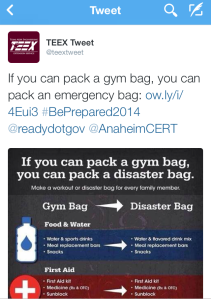| 14-005: The wrong hashtag and checking official accounts |
| Agency: TEEX |
Topic(s): Official accounts and hashtags |
| Date: Fall 2014 |
Platform: Twitter |
Citing the original source of information is a solid idea on Twitter. But citing the correct source with the correct Twitter handle is even more important. That’s what Texas A&M Engineering Extension Service (TEEX) did when they tweeted information about a gym bag/emergency preparedness kit.

The use of the wrong hashtag will drive your audience away from national trends. Remember, the general idea behind the hashtag is to help bring together trending posts especially this month because September is National Preparedness Month. My. Favorite. Month.
A quick search of “#Prepared2014” shows tens of thousands of tweets.
A search using “#BePrepared2014” yielded 13 tweets.
Those two letters really do make a difference. A big difference.
Also, when citing sources, make sure they are current agency accounts. The @readydotgov account has tweeted twice in 2014 and has 396 followers.
It also states in the description box “please follow us @Readygov”
The verified @Readygov Twitter account has 3,000 tweets with almost 90,000 followers and has been tweeting since August 2008.

No matter how good your communications plans are, your mechanical no-look cut/paste actions must be double checked every time. It takes five seconds to check. Additionally, you stand the possibility of your readers questioning the validity of your information when they see that you posted old/not used stuff.
A more effective tweet could have read:
If you can pack a gym bag, you can pack an emergency bag: ow.ly/i/4Eui3 #Prepared2014 #NatlPrep @ReadyGov @AnaheimCERT
By phrasing it this way:
- You cite FEMA’s main current preparedness Twitter account (@ReadyGov).
- You use the correct national hashtag to increase visibility in your message (#Prepared2014).
- You add additional hashtags to help pair your efforts with national campaign themes in your message.
- You cite the right agency accounts on Twitter which will help them gain visibility with your audience.
- Your agency shows coordinated efforts with national response agencies when you use @mentions on twitter.
Time is valuable, so tweet good stuff.
@rusnivek
***To download this as a single-page printable format, click this:
TheWrongHashtagAndCheckingOfficialAccounts-Safety-PIO-SM-14-005a




















